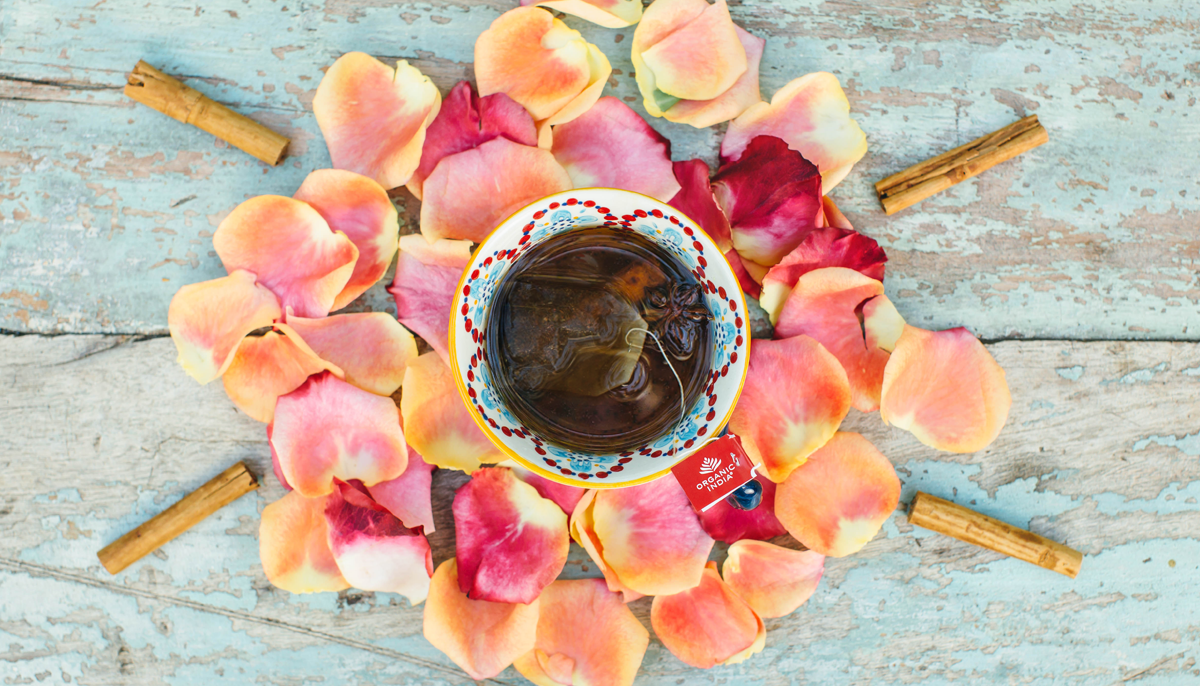Ancient traditions, including Shamanic and Ayurvedic models, regard all things in all “kingdoms,” — animal, mineral, and vegetable — as having distinct, enlivening energy signatures, or “spirits.”
In Ayurveda, these energy signatures, viewed as types of life force, are called “prana.” Like “chi” in Chinese medicine, these energies are intrinsic to everything in existence. While modern science has identified millions of distinct genetic combinations, so does prana manifest in ways unique to each living thing.
Rose: The Ayurvedic King of Flowers
The ancient Vedics called the rose the “King of Flowers.” Seen as corresponding to the physical heart, roses continue to be used in Ayurvedic formulas to and calm and balance the heart. The most commonly used rose in Ayurveda, Rosa Centifolia, is called Shatapattri in Sanskrit, meaning “one hundred petals.”
Ayurveda identifies three doshas, or physical predispositions, based on combinations of the elements fire, water, earth, air, and ether. The pitta dosha is predominantly fire with the addition of some of the water element. Pitta’s fiery nature, when unchecked, can lead to physical inflammation along with anger and frustration. Ayurvedic practitioners suggest using rose formulas or teas to relieve stress and irritability and calm turbulent emotions. They believe that rose-based infusions have the ability to transform anger to forgiveness.
Modern Science Confirms Ancient Wisdom
In a research review of Rosa Centifolia published in the International Journal of Research in Pharmacy and Chemistry, the authors confirm multiple therapeutic characteristics of this rose species.
According to the authors, “The roots are useful in intestinal ulcers, rickets, hemorrhages and diarrhea. The leaves are used in treating wounds, ophthalmia, hepatopathy and hemorrhoids. The flowers have cooling, cardio tonic, anti-inflammatory, expectorant, digestive, carminative, rejuvenating and tonic properties. Tea made from petals can be used as a blood purifier, and for headache. The petals are rejuvenating and prove to be a tonic.”
The Subtle Energy of Rose
Now that scientific instrumentation can detect more and more subtle frequencies, research confirms that everything in existence has a unique electromagnetic signature. In 1992, researcher Bruce Tainio invented instrumentation that could detect precise electromagnetic bio-signatures.
Tainio explored bio-electric energetic plant signatures, and discovered that of all the species he tested, roses had the highest frequency at 320 MHz. As a comparison, lavender came next, with a frequency of 118 MHz. In this case, the higher the frequency, the more refined the plant energy.
In the 1930s, a British medical doctor, Edgar Bach, sought methods to cure underlying imbalances in the body that lead to disease. He was convinced that emotional distress led to physical suffering just as night follows day. Bach devoted himself to finding ways to heal troubled souls to prevent physical dysfunction.
Ignoring derision from his medical colleagues, Bach explored homeopathy and other alternative modalities. He moved on to studies of native plants growing in the Welch and English countrysides. This led to his method of formulating energetic remedies from wildflowers and other plant species. Bach’s original 38 remedies became the foundation of the Bach Flower Remedy system available today.
In regard to Bach’s rose flower remedy he wrote, “This remedy is for those who without apparently sufficient reason become resigned to all that happens, and just glide through life, take it as it is, without any effort to improve things and find some joy. They have surrendered to the struggle of life without complaint.” He suggested his rose essence as a means to recover a sense of the joy of life.

Harnessing the Benefits of Roses
It’s easy to bring the health-giving properties of roses into your life, but it’s a wise choice to use rose-based products that are free of pesticides and contaminants. Products made with organic roses are preferable.
Organic India’s Sweet Rose Tea is an infusion of Tulsi, also known as Holy Basil, and rose. Organic India’s roses are sourced from the company’s Bhrindavan organic farm near Lucknow, India.
Thirsty for More?
About ORGANIC INDIA
ORGANIC INDIA produces Tulsi teas and herbal supplements that are not only good for your body, but good for the earth. Based in India, we’re dedicated to making organic, GMO-free, vegetarian products that are created using sustainable, ethical, and socially responsible methods. Our products include teas, supplements and foods, all grown in our farmlands in northern India.
20 years ago we set out to create a herbal medicine company that was close to our hearts. Our plan was to export India’s ancient Ayurvedic medicinal wisdom, in the form of herbal formulas and supplements, to the West. Yet after witnessing the critical and toxic state of India’s agriculture, we realised that our mission would be far better served working across the supply chain ourselves, starting with the health of the land and the farmers, all the way through to the consumer. We now work with over 2000 rural family farmers to cultivate over 10,000 acres of organic farmland in India.
Subscribe to our newsletter
Subscribe to our newsletter for up-to-date news, new products and special offers. Be apart of our beautiful community inspiring True Wellness for all.
